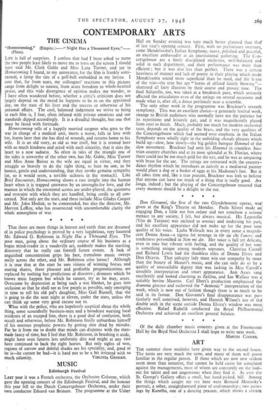ART
THE summer show matinees have given way to the second house. The turns are very much the same, and many of them will prove familiar to the regular patron. If those which are now new seldom seem more than tentative, that cannot be held cause for complaint against the managements, most of whom are constantly on the look- out for talent and not ungenerous when they find it. As ever the St. George's Gallery offers a small, but hand-picked, bill. Among the things which caught my eye here were Bernard Meninsky's portrait, a sober, straightforward piece of craftsmanship ; two paint- ings by Kanelba, one of a dancing peasant, which shows a certain formalisation, and the other, of two children playing soldiers, showing a more Slavonic sentimentality ; two pictures by another Polish painter, Marek, and an excellent, sweet, Rosoman.
The very much larger exhibition at the Leicester Galleries—part two of " Fame and Promise "—includes Kokoschka's Stockholm Harbour. This big, blue canvas dates from the autumn of 1917, and is therefore one of the first of the long series of dramatic land- scapes which was to bring fame to the painter on the Continent. In the same room there is a first-rate John Nash, one of Louis le Brocquy's less artfiicial and therefore better Tinker Men, a Keith Vaughan worth noting. The other oils include that early Victor Pasmore, Wine Bottles, delightful in its easy charm of colour ; a light, decorative Hans Tisdall and Carol Weight's Cockles and Mussels—a painting which gains by the absence of those forced accents which often refuse to take their place in Weight's work. Among the drawings here I noticed two small heads by Noel Fish, a Palmer-like landscape by Guy Burn, a Walter Goetz, and two by Kenneth Rowntree, whose placing and balance remain as assured as ever.
Lefevre's mixed show is more hermetic, ranging as it does through the painters always associated with this gallery—the early London Groupers, the Scotsmen who went to Paris—to the younger genera- tion of today. A fiery Matthew Smith nude, an iridescent David Jones watercolour, and a large Frances Hodgkins portrait, which I cannot recall seeing before, are all worth noting. The large MacBryde figure which is exhibited has been bought by the Museum of Modern Art in New York. I cannot think that this shows the painter at his best, however, but rather Colquhoun at his worst. The still-life adjoining has all the splendour of colour and a more valid and logical pattern-making. Often MacBryde's shapes, when super- imposed upon large forms as, for example, in the body of this particular figure, seem to lack the underlying grasp of structure and form to be found in the best of Colquhoun's work—say, in the head of No. 13, a woman with a cat. John Minton continues his series of portraits of students, and is here represented by two excellent examples in low, rich colour. An earlier gouache landscape may



































 Previous page
Previous page